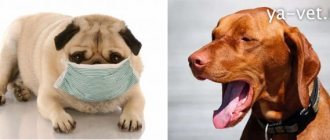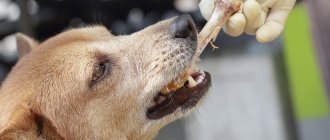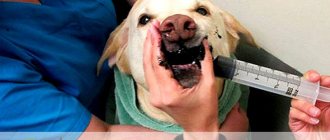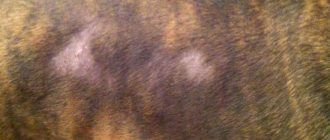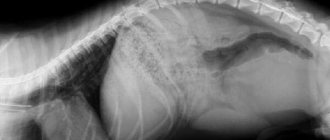Yorkshire terriers are small dogs and, due to the structure of their faces, periodically frighten their owners with a characteristic cough. In this case, the Yorkie coughs as if she was choking and may even grunt slightly. This is a physiological phenomenon and should not frighten the owner. The fact is that the structure of a dog’s muzzle is somewhat different from other breeds. Hence the occurrence of periodic suffocation, which causes a coughing attack. At the same time, a complete feeling is created that the dog is choking and trying to regurgitate something.
Why does a dog cough?
The causes of cough in dogs can be very diverse. Conventionally, they can be divided into two groups: those associated with diseases of internal organs and household ones. Among the first are often found:
- bacterial, viral, fungal infections of the nasopharynx, respiratory tract, lungs;
- heart diseases;
- allergies;
- neoplasms;
- helminthiases.
Factors of the second group that provoke a cough reflex in an animal include the following.
Check to see if the collar is too tight on your dog's throat - this may be the cause of the cough.
- Tight collar. The dog coughs when it is over-tightened (“so as not to run away”), if the collar has become small, while the leash is being pulled. The latter is especially typical for young, overly active pets. Coughing is often associated with a leash in dogs with too short or, conversely, long necks. In the first case, it is preferable to use a harness, and in the second, carefully select the width of the accessory.
- Accumulation of hair in the esophagus and stomach. The problem is typical for four-legged animals with long hair. When licking (although not frequently), the dog involuntarily swallows hair, which does not move along the digestive tract, but gradually collects in a lump in the stomach or esophagus. Such accumulations lead to a gag and cough reflex. At the same time, the dog coughs as if he was choking.
- A foreign object is stuck in the throat. Anything can get stuck: a thread, New Year's rain, a fish bone, a chicken bone. The thread, if it is not completely swallowed, will irritate the mucous membrane of the oropharynx and esophagus for a long time, causing coughing and vomiting. Sharp bones, piercing the tissues of the oral cavity, pharynx, and esophageal wall, not only create a feeling of interference in the animal, but also lead to inflammatory processes (suppuration, pain, swelling of the mucous membrane, etc.).
- Features of the anatomical structure of the pet's respiratory tract, oropharynx and esophagus. Short-faced animals are characterized by the so-called reverse sneezing. This is a paroxysmal cough, not associated with diseases, that occurs suddenly and passes quickly, without outside help.
Reverse sneezing
This sign is more common in dogs of dwarf breeds with a long, narrow muzzle (toy poodle). Outwardly, it looks as if the pet has got something in its nose and is frantically trying to sneeze it out. At the same time, he draws in air and makes grunting sounds, coupled with shortness of breath and noisy breathing.
More often than not, this is not a dangerous symptom. It is necessary to do an ECHO, X-ray and exclude tracheal collapse and heart failure. The attack is short-lived, a maximum of 10 minutes; if you massage the back of the nose, it stops, the dog calms down and stops grunting.
The reasons for this phenomenon have not been studied; there is an assumption that this is due to a certain type of structure of the larynx, as well as dust and pollen entering the nasopharynx. There is no treatment.
Types of cough in dogs
Cough in dogs is classified based on several characteristics. It is important that the owner, when contacting a veterinary clinic, can talk about each of them in sufficient detail.
Parameter
Type of cough
Presence/absence of sputum
- Wet (with mucus)
- Dry (without it)
Character of the course
- Acute (appears sharply, pronounced)
- Subacute (develops progressively, gradually intensifying)
- Chronic (lasts a long time)
Severity of manifestation
- Minor
- Strong
- Paroxysmal
Cough frequency
- Rare
- Frequent
In addition, there is a seasonal cough - an allergic reaction of the pet’s body to changes in nature.
Causes of cough
The causes of cough in dogs can be external, mechanical, or internal in nature.
Mechanical injuries include cases where an animal has swallowed a foreign body, as well as chest injuries.
Internal factors of occurrence represent a broad group. In these situations, cough is a secondary symptom and develops against the background of the underlying disease. Among the most common are:
- Allergic reactions;
- Acute tracheobronchitis;
- Cardiovascular diseases;
- Pneumonia;
- Infections, worms.
Associated symptoms
Coughing in dogs can occur on its own or be accompanied by other symptoms. Among them:
- vomit;
- blood in sputum;
- foamy discharge from the mouth;
- temperature increase;
- refusal of food;
- muscle weakness (the animal has difficulty moving);
- breathing problems, shortness of breath, and so on.
Some diseases develop rapidly and can lead to the death of your pet. If your dog's condition suddenly worsens, you should immediately contact a veterinarian.
Symptoms that indicate a pathological cough
In order not to miss the onset of a serious illness, your Yorkie must be closely monitored.
With a pathological cough, the dog opens its mouth wide, and its body temperature changes.
The following symptoms will indicate the development of pathology to the owner:
- noisy dog breathing;
- during inhalation and exhalation, too active work of the muscles of the chest and peritoneum is observed - the animal’s stomach sinks strongly, and the chest expands significantly;
- when breathing, the Yorkie opens its mouth too wide;
- the dog may experience a rise in general temperature;
- when examining the mouth, the bluish color of the mucous surfaces and tongue is recorded;
- there is a change in the timbre of the voice (the Yorkie begins to bark differently).
If such symptoms develop, the dog must be urgently shown to a veterinarian.
Diagnosis of cough in a dog
A dog's cough can cause serious illness, so it is recommended that you take your pet to see a veterinarian.
At the veterinarian's appointment, the pet will be examined and the owner will be questioned. It will be necessary to talk about the characteristics of the cough, its duration, and the conditions accompanying its occurrence. You will need to provide information about the dog’s age, the presence of any diseases, vaccinations, living conditions, etc. The complex of diagnostic procedures may include methods such as:
- X-ray;
- bronchoscopy;
- ECG;
- cytological, bacteriological examination of sputum.
Cough when a foreign body enters the respiratory tract
As a rule, if a dog chokes or swallows something extra, it copes with the situation on its own by coughing up. At such a moment, the cough begins suddenly, sharply, accompanied by corresponding movements of the neck and head, and a characteristic posture.
There may be another situation: the animal choked on a sharp bone, an object that, due to its shape or size, got caught in the mucous membrane. Then the following symptoms may appear:
- cough in fits and starts, prolonged, debilitating;
- during the cough reflex, the pet tries to push the foreign body out of the throat;
- wheezing;
- difficulty breathing;
- foam from nostrils;
- cough with blood, foam;
- refusal to drink and eat.
You cannot hope that the dog will cope on its own. Trying to pull out (or even see) what got into her throat is almost impossible without special tools. The animal needs to be taken to the clinic urgently. Delay threatens the development of emphysema, inflammatory processes in the bronchi, lungs, pleura and other complications.
Aviary (kennel) cough in a dog
Aviary cough is a symptom of some infectious (mainly viral) diseases of dogs, so named because of the most common cause of infection - living together or frequent contact of animals with each other. The source of infection is a sick or recovering dog.
Signs of the disease are determined by the characteristics of the pathogen (parainfluenza, canine herpes, bordetella), as well as the state of the animal’s immune system. After the incubation period (up to 10 days) has passed, the following manifestations of pathology are possible:
- a slight paroxysmal cough, similar to the dog choking, but less pronounced;
- cough with white foam;
- swollen lymph nodes;
- increase in temperature indicators;
- lacrimation;
- discharge from the nostrils.
Kennel cough lasts approximately 2 weeks. The stronger the dog’s immunity, the easier it tolerates the infection, sometimes without even requiring special treatment. In severe cases, the use of antibacterial, antiviral, expectorant, immunomodulatory and other agents is indicated (based on examination results).
Features of cough in dogs with certain diseases
The cough reflex only indicates the presence of a pathological process in the body, and is not an independent disease. What type of cough occurs in dogs depends on the underlying disease. Knowing the characteristics of cough syndrome and accompanying symptoms will speed up the diagnosis and allow you to provide your pet with timely treatment and first aid.
Allergic reaction
Allergies in dogs manifest themselves in a variety of symptoms. The cough may be accompanied by:
A dog's cough may be caused by an allergic reaction.
- discharge from the nostrils, eyes;
- swelling of the mucous membranes;
- redness of the eyes;
- sneezing;
- skin rashes;
- itching and other symptoms.
The owner should monitor the pet; perhaps cough and other signs appear after eating certain foods, after a walk, and are seasonal. If an allergen is identified, it is excluded from the dog’s life and appropriate therapy is carried out.
Bronchitis
The inflammatory process in the bronchi - bronchitis - is initially accompanied by a dry, severe cough from your pet. It is most pronounced in the morning: wheezing and whistling are heard. After a few days, the cough becomes wet and whitish or yellowish sputum appears. Additional symptoms of the disease include shortness of breath, difficulty breathing, and increased body temperature.
The owner should know that bronchitis can be both viral and bacterial, so treatment in both cases will be different. You can determine the pathogen “by eye” by the severity of the symptoms: with the bacterial form they are stronger, and the dog’s condition is much worse. In addition, if bronchitis is caused by bacteria, the pet’s body temperature will be 2 degrees or more above normal (with a viral infection it rises within one degree).
Helminthiasis
The life cycle of some parasites is associated with the migration of swallowed larvae from the stomach and intestines to the lung tissue. The helminths spend about 2 weeks in the respiratory organs, and then they are expectorated, swallowed along with sputum, and grow into adults in the intestines.
While in the dog's lungs, worms lead to the following symptoms:
- wet cough mixed with blood;
- difficulty breathing, shortness of breath;
- temperature rise, sometimes quite strong, up to 43 °C.
It is possible to say with greater certainty that the cough has a parasitic cause if, shortly before these manifestations, the animal had problems with digestion, pain in the intestines, or diarrhea.
Pulmonary infarction
Dogs with cardiovascular pathologies are at risk of developing pulmonary infarction. This may occur due to a blood clot breaking off. A characteristic sign is severe, sharp pain, during which the animal jumps and may scream. Almost immediately, shortness of breath and coughing with blood mucus begins. The dog weakens before our eyes, the mucous membranes turn pale, the heartbeat is disrupted, blood pressure drops, and the temperature rises. The pet should be taken to the clinic immediately.
Laryngitis
Inflammation of the dog's pharynx is also accompanied by a cough. At the early stage of the disease, it causes suffering to the animal: a dry and persistent cough causes pain, so the pet may refuse to eat, stop barking (or make hoarse, hoarse sounds). Gradually, the cough reflex becomes productive, a small amount of sputum is released, and as the inflammatory process in the mucous subsides, pain disappears. Body temperature remains within normal limits or rises slightly.
Adenovirus
This disease is of viral origin. The mucous membrane of the upper respiratory tract and throat is affected. Symptoms of adenovirus:
- sore throat (the animal reacts accordingly when palpation is attempted);
- enlarged lymph nodes under the jaw;
- productive cough;
- cough discharge may be clear or cloudy;
- lacrimation;
- discharge from the nostrils;
- slight increase in temperature indicators;
- refusal of food;
- in the intestinal form, vomiting, nausea, indigestion, diarrhea and pain in the intestinal area are observed.
Heart diseases
If your dog has heart defects or disease, he may develop a heart cough. It is characterized by pink color of sputum, due to the leakage of blood into the lungs through the capillary walls. Foamy pink discharge from the respiratory system is accompanied by other symptoms of heart failure:
- increased cough after physical activity;
- weakness of the animal;
- labored breathing;
- mucous membranes acquire a bluish tint.
Heart cough in four-legged friends, unfortunately, has a poor prognosis. At best, the dog can live 2-4 years. The pathology can only be treated surgically, but due to the complexity and high cost of operations, they are not performed.
Bronchial asthma
The development of bronchial asthma in a dog can be triggered by prolonged exposure to various allergens, volatile chemical compounds, nervous stress, weather conditions, and infectious diseases. The dog coughs as if it was choking, accompanying the attacks with corresponding movements of the head and body. Characteristic signs of the disease are:
- the appearance of attacks after physical stress, their absence during rest;
- discharge of thick transparent mucus from the bronchi;
- bluish mucous membranes;
- suffocation during an attack;
- redness of the eyes;
- sneezing.
Neoplasms of various origins
Tumors in the nasopharynx are diagnosed more often in dogs after 7-8 years of age and cause a specific sound reminiscent of grunting. The first signs appear suddenly in the form of shortness of breath or difficulty swallowing. The faster the tumor grows, the stronger the symptoms; it becomes difficult for the pet to eat and breathe, especially during physical exertion; he tries to “cough up” and remove the interfering tumor.
Carcinomas are found in the larynx, polyps and sarcomas are found in the nose. Favorable prognosis for polyps. If they are detected in a timely manner, surgery is performed and removed. With sarcomas and carcinomas, everything depends on the stage of the pathological process and the degree of tumor penetration into healthy tissue. In case of metastasis to other organs, surgical treatment is not justified.
Cough in small dogs
Chihuahua coughing
Coughing in small breed dogs is a common occurrence due to the structural features of the pharynx, respiratory tract, maxillofacial apparatus, and the location of the teeth. Thus, due to the accumulation of bacteria, insufficient oral and dental hygiene, the pet may develop gingivitis, stomatitis and other inflammatory processes. The infection gradually spreads to the mucous membrane of the larynx and trachea, settles in the pharyngeal tonsils, and descends into the lungs.
The deep location of the tonsils plays a major role in the development of inflammation and cough. Their increase in response to an infectious invasion leads to a narrowing of the lumen of the larynx, difficulty breathing, and shortness of breath. If this situation occurs frequently, the tonsils must be removed. For preventive purposes, the owner of a small dog should regularly show the pet to a veterinarian in order to promptly identify and eliminate problems with the teeth and oral cavity.
What you need to pay special attention to
If your dog coughs too often, you need to pay attention to the following signs:
- How long ago did the cough start?
- What sound does the pet make?
- How does a four-legged animal tolerate this condition?
- What color is the sputum coming out and is there pus and blood in it?
- Does the dog have problems swallowing food?
- What an appetite she has.
It is also important for the owner to remember the details that preceded this condition: did the pet communicate with its relatives, in particular with strangers, what did it eat, did it walk on its own without the supervision of the owner.
After listening to all the facts, the doctor will examine the pet, checking the condition of the teeth, gums and mucous membranes. The heartbeat will also be checked, after which it will be possible to make a correct diagnosis and understand the root cause of the cough.
If hospitalization is not required, the veterinarian will tell you how to treat this or that disease at home.
A dog has a coughing attack: what to do to prevent choking
It’s one thing when a dog chokes or coughs, but copes with the situation on its own. However, it happens that the pet requires outside help - the attack can be prolonged, and the animal begins to choke. Choking can be prevented by following a few tips.
- If this is an attack of reverse sneezing, then you should ensure that the saliva that has accumulated in the mouth is swallowed and takes a deep breath. This is achieved by pinching the four-legged friend’s nose or running the palm across the throat several times.
- It is advisable to turn the pet over so that the head is lower than the body and limbs. You can shake the animal and give it a series of slaps on the back. If your pet is large, you can raise its hind legs (the dog must stand) and also make several claps at chest level.
- In short-snouted pets, the airways may become blocked by surrounding soft tissues. If the dog is choking, you can check the free passage of air with your finger.
- If the animal is not breathing, you need to urgently begin resuscitation efforts: ensure the supply of oxygen to the respiratory organs and massage the heart area.
Attention: after such an attack, the animal must be shown to a veterinarian.
How to help York with a physiological cough attack
What to do if your Yorkie coughs just like that?
There are several recommendations that will help your dog:
- Pinch his nose. In this case, the dog will be forced to open its mouth and take a breath. In most cases, this technique helps the dog get rid of the cough.
- During an attack, lightly massage the animal's throat. This massage will help relax the tense tracheal muscles and allow the dog to breathe normally.
- If the cough is caused by stressful situations, then your pet can be given sedatives. The veterinarian should select the medications.
If your Yorkie coughs a lot, you can gently massage his throat.
If your Yorkie suddenly coughs, don’t panic. If he does not have additional pathological symptoms, then the cough will go away on its own without harming the dog. Plus, you know how to make it easier.

